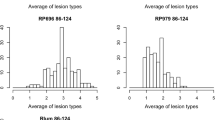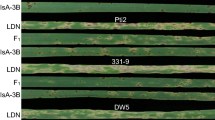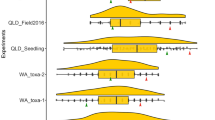Abstract
Tan spot, caused by Pyrenophora tritici-repentis (Ptr), is an economically important foliar disease in the major wheat growing areas of the world. Multiple races of the pathogen have been characterized based on their ability to cause necrosis and/or chlorosis in differential wheat lines. Isolates of race 5 cause chlorosis only, and they produce a host-selective toxin designated Ptr ToxB that induces chlorosis when infiltrated into sensitive genotypes. The international Triticeae mapping initiative (ITMI) mapping population was used to identify genomic regions harboring QTLs for resistance to fungal inoculations of Ptr race 5 and to determine the chromosomal location of the gene conditioning sensitivity to Ptr ToxB. The toxin-insensitivity gene, which we are designating tsc2, mapped to the distal tip of the short arm of chromosome 2B. This gene was responsible for the effects of a major QTL associated with resistance to the race 5 fungus and accounted for 69% of the phenotypic variation. Additional minor QTLs were identified on the short arm of 2A, the long arm of 4A, and on the long arm of chromosome 2B. Together, the major QTL on 2BS identified by tsc2 and the QTL on 4AL explained 73% of the total phenotypic variation for resistance to Ptr race 5. The results of this research indicate that Ptr ToxB is a major virulence factor, and the markers closely linked to tsc2 and the 4A QTL should be useful for introgression of resistance into adapted germplasm.




Similar content being viewed by others
References
Ali S, Francl LJ, DeWolf ED (1999) First report of Pyrenophora tritici-repentis race 5 from North America. Plant Dis 83:591
Anderson JA, Effertz RJ, Faris JD, Francl LJ, Meinhardt SW, Gill BS (1999) Genetic analysis of sensitivity to Pyrenophora tritici-repentis necrosis-inducing toxin in durum and common wheat. Phytopathology 89:293–297
Ballance GM, Lamari L, Bernier CC (1989) Purification and characterization of a host selective toxin from Pyrenophora tritici-repentis. Phys Mol Plant Pathol 35:203–213
Brown DA, Hunger RM (1993) Production of a chlorosis-inducing, host-specific, low-molecular weight toxin by isolates of Pyrenophora tritici-repentis, cause of tan spot of wheat. J Phytopathol 137:221–232
Dumas B, Freysinet G, Pallett KE (1995) Tissue-specific expression of germin-like oxalate oxidase during development and fungal infection of barley seedlings. Plant Physiol 107:1091–1096
Effertz RJ, Anderson JA, Francl LJ (2001) Restriction fragment length polymorphism mapping of resistance to two races of Pyrenophora tritici-repentis in adult and seedling wheat. Phytopathology 91:572–578
Effertz RJ, Meinhardt SW, Anderson JA, Jordahl JG, Francl LJ (2002) Identification of a chlorosis-inducing toxin from Pyrenophora tritici-repentis and the chromosomal location of an insensitivity locus in wheat. Phytopathology 92:527–533
Elias E, Cantrell RG, Hosford RM Jr (1989) Heritability of resistance to tan spot in durum wheat and its association with other agronomic traits. Crop Sci 29:299–304
Faris JD, Anderson JA, Francl LJ, Jordahl JG (1996) Chromosomal location of a gene conditioning insensitivity in wheat to a necrosis-inducing culture filtrate from Pyrenophora tritici-repentis. Phytopathology 86:459–463
Faris JD, Anderson JA, Francl LJ, Jordahl JG (1997) RFLP mapping of resistance to chlorosis induction by Pyrenophora tritici-repentis in wheat. Theor Appl Genet 94:98–103
Faris JD, Li WL, Liu DJ, Chen PD, Gill BS (1999) Candidate gene analysis of quantitative disease resistance in wheat. Theor Appl Genet 98:219–225
Friesen TL, Ali S, Kianian S, Francl LJ, Rasmussen JB (2003) Role of host sensitivity to Ptr ToxA in development of tan spot of wheat. Phytopathology 93:397–401
Gamba FM, Lamari L (1998) Mendelian inheritance of resistance to tan spot (Pyrenophora tritici-repentis) in selected genotypes of durum wheat (Triticum turgidum). Can J Plant Pathol 20:408–414
Gamba FM, Lamari L, Brule-Babel A (1998) Inheritance of race-specific necrotic and chlorotic reactions induced by Pyrenophora tritici-repentis in hexaploid wheats. Can J Plant Pathol 20:401–407
Haley CS, Knott SA (1992) A simple regression method for mapping quantitative trait loci in line crosses using flanking markers. Heredity 69:315–324
Hurkman WJ, Tanaka CK (1996) Germin gene expression is induced in wheat leaves by powdery mildew infection. Plant Physiol 111:735–739
Kosambi DD (1944) The estimation of map distances from recombination values. Ann Eugen 12:172–175
Lamari L, Bernier CC (1989a) Evaluation of wheat lines and cultivars for reaction to tan spot Pyrenophora tritici-repentis based on lesion size. Can J Plant Pathol 11:49–56
Lamari L, Bernier CC (1989b) Toxin of Pyrenophora tritici-repentis: host-specificity, significance in disease, and inheritance of host reaction. Phytopathology 79:740–744
Lamari L, Bernier CC (1991) Genetics of tan necrosis and extensive chlorosis in tan spot of wheat caused by Pyrenophora tritici-repentis. Phytopathology 81:1092–1095
Lamari L, Sayoud R, Boulif M, Bernier CC (1995) Identification of a new race of Pyrenophora tritici-repentis: implications for the current pathotype classification system. Can J Plant Pathol 17:312–318
Lamari L, Strelkov SE, Yahyaoui A, Orabi J, Smith RB (2003) The identification of two new races of Pyrenophora tritici-repentis from the host center of diversity confirms a one-to-one relationship in tan spot of wheat. Phytopathology 93:391–396
Lander ES, Botstein D (1989) Mapping Mendelian factors underlying quantitative traits using RFLP linkage maps. Genetics 121:185–199
Lander ES, Green P, Abrahamson J, Barlow A, Daly MJ, Lincoln SE, Newberg L (1987) MAPMAKER: an interactive computer package for constructing primary genetic linkage maps of experimental and natural populations. Genomics 1:174–181
Lee TS, Gough FJ (1984) Inheritance of Septoria leaf blotch (S. tritici) and Pyrenophora tan spot (P. tritici-repentis) resistance in Triticum aestivum cv. Carifen 12. Plant Dis 68:848–851
Li WL, Faris JD, Chittoor JM, Leach JE, Hulbert SH, Liu DJ, Chen PD, Gill BS (1999) Genomic mapping of defense response genes in wheat. Theor Appl Genet 98:226–233
Manning VA, Pandelova I, Ciuffetti LM (2002) A race for a novel host selective toxin. Phytopathology 92:S51
Marino CL, Nelson JC, Lu YH, Sorrells ME, Lopes CR, Hart GE (1996) Molecular genetic linkage maps of the group 6 chromosomes of hexaploid wheat (Triticum aestivum L. em. Thell). Genome 39:359–366
Martinez JP, Ottum SA, Ali S, Francl LJ, Ciuffetti LM (2001) Characterization of the ToxB gene from Pyrenophora tritici-repentis. Mol Plant Microbe Interact 14:675–677
Nagle BJ, Frohberg RC, Hosford RM Jr (1982) Inheritance of resistance to tan spot of wheat. In: Hosford RM Jr (ed) Tan spot of wheat and related diseases workshop, North Dakota Agric Exp Station, Fargo, pp 40–45
Nelson JC (1997) QGENE: software for marker-based genomic analysis and breeding. Mol Breed 3:239–245
Nelson JC, Sorrells ME, Van Deynze AE, Lu YH, Atkinson M, Bernard M, Leroy P, Faris JD, Anderson JA (1995a) Molecular mapping of wheat. Major genes and rearrangements in homologous groups 4, 5, and 7. Genetics 141:721–731
Nelson JC, Van Deynze AE, Autrique E, Sorrells ME, Lu YH, Merlino M, Atkinson M, Leroy P (1995b) Molecular mapping of wheat. Homologous group 2. Genome 38:516–524
Nelson JC, Van Deynze AE, Autrique E, Sorrells ME, Lu YH, Negre S, Bernard M, Leroy P (1995c) Molecular mapping in wheat. Homologous group 3. Genome 38:525–533
Orolaza NP, Lamari L, Ballance GM (1995) Evidence of a host specific chlorosis toxin from Pyrenophora tritici-repentis, the causal agent of tan spot of wheat. Phytopathology 85:1282–1287
Röder MS, Korzun V, Wendehake K, Plaschke J, Tixier M-H, Leroy P, Ganal MW (1998) A microsatellite map of wheat. Genetics 149:2007–2023
Strelkov SE, Lamari L, Ballance GM (1999) Characterization of a host-specific protein toxin (Ptr ToxB) from Pyrenophora tritici-repentis. Mol Plant Microbe Interact 12:728–732
Sykes EE, Bernier CC (1991) Qualitative inheritance of tan spot resistance in hexaploid, tetraploid, and diploid wheat. Can J Plant Pathol 13:38–44
Tomás A, Bockus WW (1987) Cultivar specific toxicity of culture filtrate of Pyrenophora tritici-repentis. Phytopathology 77:1337–1366
Tomás A, Feng GH, Reeck GR, Bockus WW, Leach JE (1990) Purification of a cultivar-specific toxin from Pyrenophora tritici-repentis, causal agent of tan spot of wheat. Mol Plant Microbe Interact 3:221–224
Tuori RP, Wolpert TJ, Ciuffetti LM (1995) Purification and immunological characterization of toxic components from cultures of Pyrenophora tritici-repentis. Mol Plant Microbe Interact 8:41–48
Van Deynze AE, Dubcovsky J, Gill KS, Nelson JC, Sorrells ME, Dvorak J, Gill BS, Lagudah ES, McCouch SR, Appels R (1995) Molecular-genetic maps for group 1 chromosomes of Triticeae species and their relation to chromosomes in rice and oat. Genome 38:45–59
Weise MV (1987) Compendium of wheat diseases, 2nd edn. APS Press, St. Paul
Zhang H-F, Francl LJ, Jordahl JG, Meinhardt SW (1997) Structural and physical properties of a necrosis-inducing toxin from Pyrenophora tritici-repentis. Phytopathology 87:154–160
Zhang Z, Collinge DB, Thordal-Christensen H (1995) Germin-like oxalate oxidase, a H2O2-producing enzyme, accumulates in barley attacked by the powdery mildew fungus. Plant J 8:139–145
Zhou Z, Zhang Z, Gregersen PL, Mikkelsen JD, de Neergaard E, Collinge DB, Thordal-Christensen H (1998) Molecular characterization of the oxalate oxidase involved in the response of barley to the powdery mildew fungus. Plant Physiol 117:33–41
Acknowledgments
This research was supported by USDA CRIS projects 5442-22000-030-00D and 5442-21000-026-00D. The authors thank Dr. Shaukat Ali for supplying the race 5 isolates and Phil Meyer for technical assistance.
Author information
Authors and Affiliations
Corresponding author
Additional information
Communicated by B. Friebe
Rights and permissions
About this article
Cite this article
Friesen, T.L., Faris, J.D. Molecular mapping of resistance to Pyrenophora tritici-repentis race 5 and sensitivity to Ptr ToxB in wheat. Theor Appl Genet 109, 464–471 (2004). https://doi.org/10.1007/s00122-004-1678-9
Received:
Accepted:
Published:
Issue Date:
DOI: https://doi.org/10.1007/s00122-004-1678-9




